What Size Breaker for an AC Unit?
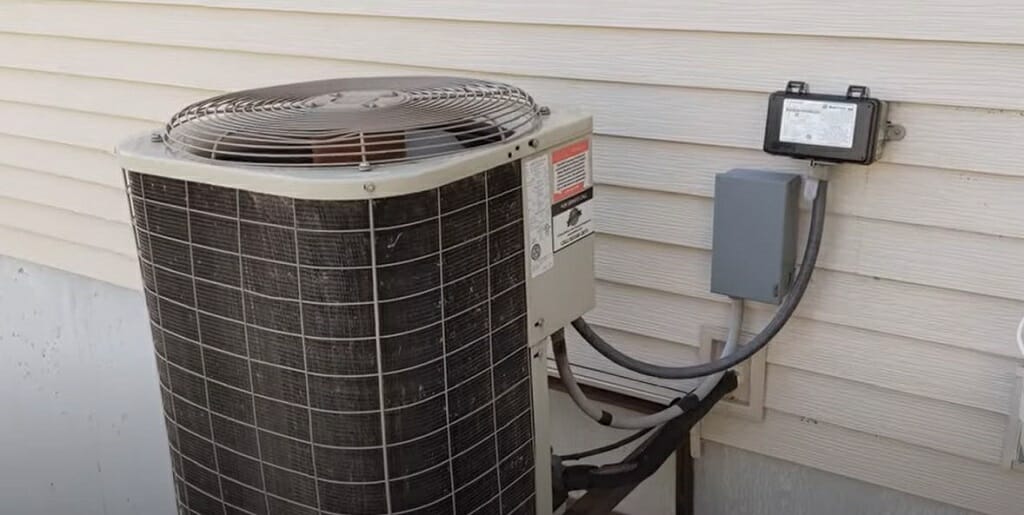
Are you having issues figuring out which breaker your AC unit uses? Here is a complete guide.
Using the wrong circuit breaker will fry the air conditioner’s circuits, or sometimes the circuit breaker will catch fire. To avoid such situations, you should pick the right breaker size for your AC unit. But in truth, this is a little tricky. For instance, the breaker size will change according to the size of the air conditioner unit. As an electrician, I face similar issues daily and hope to shed some light on this matter today.
In general, most 5+ ton AC units(220/240V) need up to 65 amp breakers. And the smaller 1-ton units (110/120V) will run smoothly on 15-amp breakers. You can follow the methods below to calculate an air conditioner’s breaker size.
- Check the MAX FUSE and MIN Circuit Ampacity values on the AC unit to determine the circuit breaker size.
- Find out the max wattage of the AC unit and use the NEC 80% rule to calculate the AC breaker size.
Read the below article for a more detailed explanation.
How Can I Figure Out the Correct Breaker Size for My AC Unit?
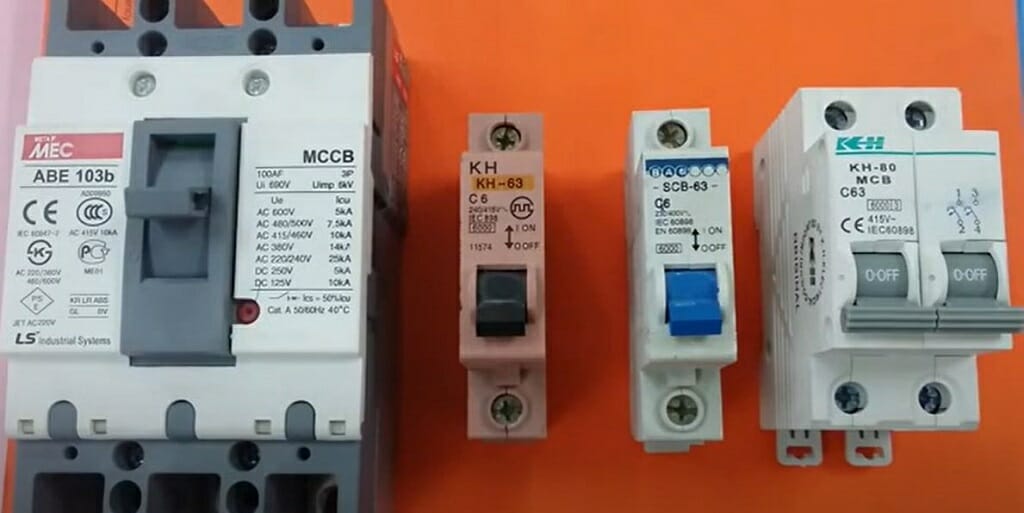
In truth, figuring out the correct air conditioner circuit breaker size for an AC unit is far more crucial than one might think. If you select the wrong circuit breaker size, it could put you in a very risky situation. For instance, you might end up with a damaged electrical circuit in the AC unit. Or it might start a fire in the circuit breaker. It would be best if you avoid both of these situations by any means.
I’ll teach you two methods to determine the correct circuit breaker size for any air conditioner unit in this guide. Whether it is a 5+ ton unit or a small 1-ton unit, by the end of the article, you’ll know how to get the perfect circuit breaker.
Method 1 – Use MAX FUSE and MIN Circuit Ampacity Values
This is the simplest and easiest method to determine the circuit breaker size for any AC unit. All you need to do is look at the data plate on the AC unit. There, you can find lots of details regarding your AC unit. But you don’t need everything. Just take the below two values.
- MAX FUSE
- MIN Circuit Ampacity
Important: I’m using an AC unit with a MAX FUSE value of 60 amp for this demonstration. And the MIN Circuit Ampacity is 34 amp. Here’s how you can determine the correct circuit breaker for this AC unit.
MAX FUSE
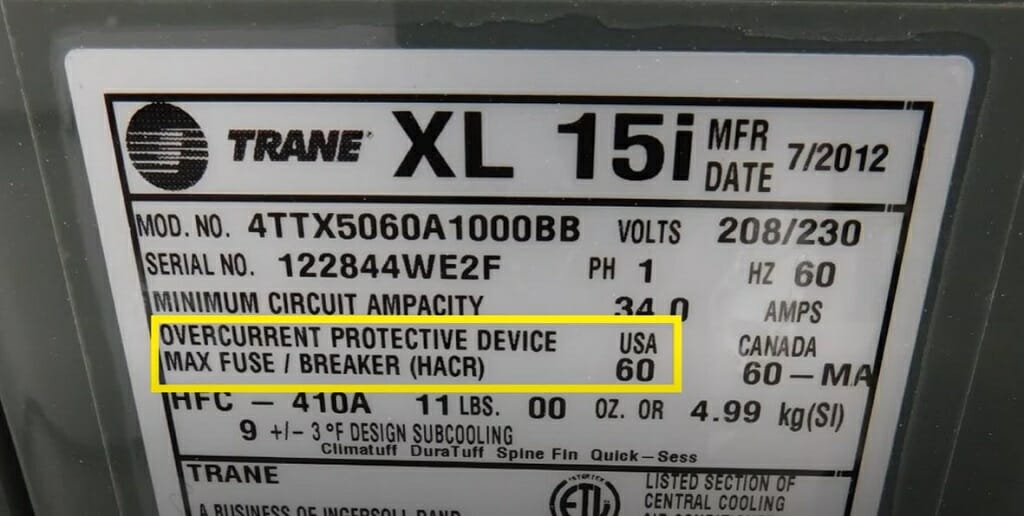
MAX FUSE value represents the maximum short circuit current that the fuse can handle. Hence, you shouldn’t expose the AC unit to a value that exceeds the MAX FUSE value. As mentioned above, I’m using an AC unit with a MAX FUSE value of 60 amps. That means I cannot use a circuit breaker larger than 60 amp.
MIN Circuit Ampacity
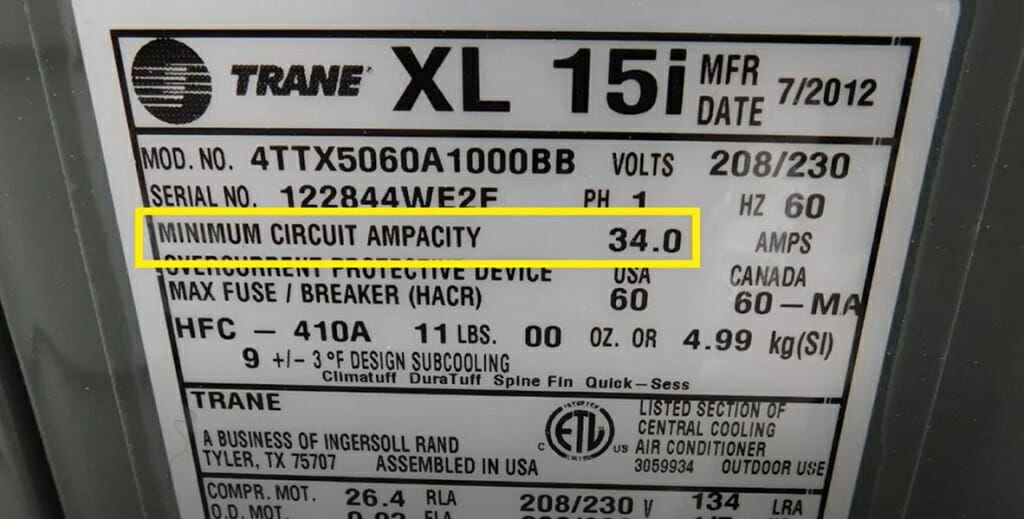
MCA, aka minimum circuit ampacity, will give you an idea of the minimum circuit breaker and wire size you’ll have to use for your AC unit. Using the correct size of the wire will prevent overheating.
Quick Tip: Overheated wires can start an electrical fire. So, use the proper wire gauge with the particular circuit breaker.
As you can see, I’m using an AC unit with a minimum circuit ampacity of 34 amp. For 34 amps, you should use an 8-gauge wire. Here’s a chart that represents different wire sizes for different circuit breakers.
| Circuit Breaker Amp Value | Minimum Wire Size (AWG) |
| 15 | 14 |
| 20 | 12 |
| 30 | 10 |
| 40 | 8 |
| 55 | 6 |
| 70 | 4 |
Because the minimum circuit ampacity is 34amp, the circuit breaker cannot go below the 34 amp mark.
What is a Suitable Circuit Breaker?
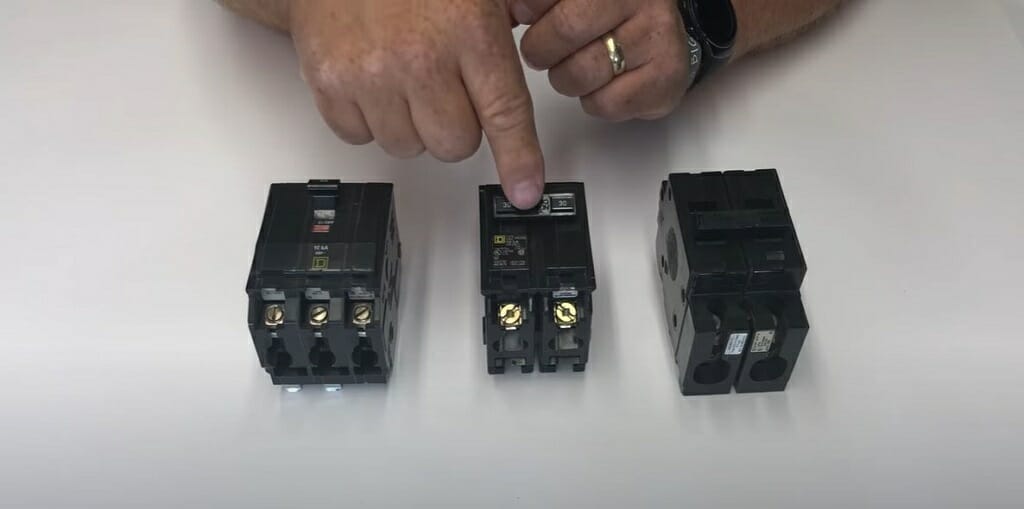
According to the above data, using a circuit breaker between 35 and 60 amps will be the best option for the above AC unit. For instance, 35 amp, 40 amp, 45 amp, 50 amp, 55 amp, and 60 amp breakers are the most suited option for this AC unit. Also, I cannot use a 30 amp breaker since the minimum circuit ampacity is 34 amp. If I do, it will damage the circuit breaker. The best choice is the 35 amp or 40 amp breaker since I’m using an 8 AWG wire.
However, the circuit breaker size might vary depending on your AC unit. For instance, your AC unit might use 120V instead of 240V.
AWG Wire
AWG stands for American Wire Gauge, the standard for measuring wire sizes in North America. This system started in 1857. Currently, the largest wire size is 0000 AWG, and the smallest is 40 AWG.
Important: If you are still unsure how to determine the correct circuit breaker for your AC unit, follow method 2.
Method 2 – Using the Max Wattage Value
In this method, you can use the max wattage value of the AC unit to calculate the correct breaker size. Also, you’ll have to use the NEC 80% rule to figure out the perfect breaker for your AC unit.
However, in some AC units, you can find the max wattage value on the data plate. And sometimes, this value won’t be available. But you don’t have to worry about that in this section. I’ll teach you both ways.
When the Max Wattage is Given:
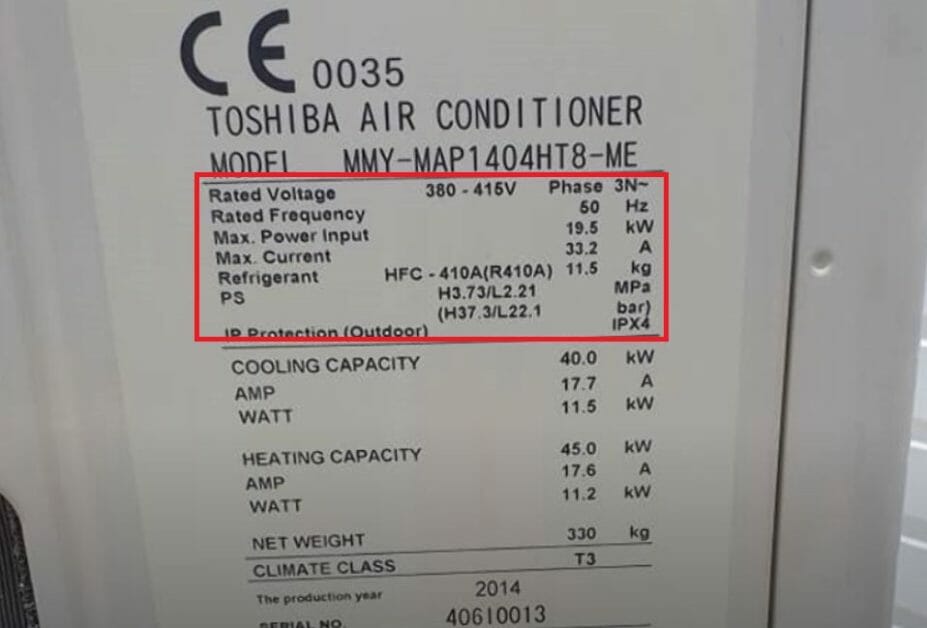
Most of the time, max wattage will be printed on the data plate. Follow the below steps to calculate the correct circuit breaker size.
Note: Assume the max wattage is 2400W for this demonstration.
According to Joule’s Law,
P = I.V
P represents the wattage, I represents the current, and V represents the voltage.
Therefore,
I = P/V
Take the V value as the 240V for this example.
I = 2400W/240V
I = 10 A
This means the particular air conditioner draws a maximum of 10 amp. However, this is not the final result. You’ll have to consider the NEC 80% rule for circuit breakers. If you aren’t familiar with the NEC 80% rule, here’s a simple explanation.
NEC 80% Rule
NEC’s 80% rule states that a circuit breaker should only be exposed to 80% of its rated value.
Follow the below calculation for a 20 amp breaker, and you’ll get a better idea about it.
Max Load = 20 amp × 80%
Max Load = 16 amp
Therefore, a 20 amp breaker should be continuously exposed to a load of 16 amps (3 hours or more).
If we apply the same NEC 80% rule for our 10 amp AC unit,
Breaker Size = 10 amp × 100/80
Breaker Size = 12.5 amp
Important: This 12.5 amp value is the MIN Circuit Ampacity we discussed in method 1.
There are no 12.5 amp breakers. So, the best choice is to use a 15 amp breaker. Remember to use suitable AWG wire for a 15 amp breaker.
Quick Tip: 14 AWG wire is the best 15 amp circuit breaker option.
When the Max Wattage Is Not Given:
If the max wattage is not printed on the data plate, you’ll have to use the following values to calculate the max wattage.
- BTU value for the AC unit
- EER rating
But first, you should understand the above two terms properly.
BTU (British Thermal Unit)
BTU value represents the total energy the AC unit uses to remove heat within an hour. This is one of the important metrics that you should look for while buying a new AC unit.
1 BTU = 1055.056 joules
EER Rating
EER stands for Energy Efficiency Ratio and is mostly used for rate air conditioners in the US. A good air conditioner should have an EER rating of 8.5 or above.
Calculating Max Wattage Value
Max AC Wattage = Capacity (in BTUs)/ EER Rating
Therefore, if we consider an AC unit that has 24000 BTUs and a 10 EER rating,
Max AC Wattage = 24000 BTU/ 10 EER
Max AC Wattage = 2400W
After finding the max wattage, you can use that value to calculate the circuit breaker size.
I = P/V
I = 2400W/240V
I = 10 A
According to the NEC 80% rule,
Breaker Size = 10 amp × 100/80
Breaker Size = 12.5 amp
You should choose a 15 amp circuit breaker with 14 AWG wires for this AC unit.
A Few Things You Should Remember During the Above Methods
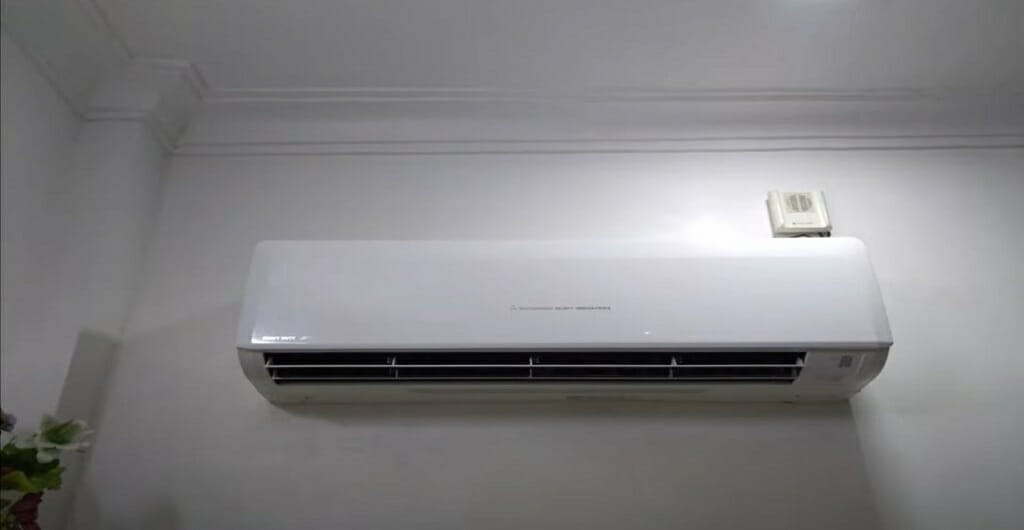
Let’s be honest; the above calculations might seem a bit complex for some home users. But in truth, they aren’t that bad. Here are some things you should remember while figuring out the perfect circuit breaker for your newly brought AC unit.
Fact 1
Smaller 1-ton AC units run on 110/120V circuits. And they come with a 15000 BTU value. The 15 amp circuit breaker is more than enough for these air conditioners.
Fact 2
Larger AC units above 1 ton run on 220/240V circuits. And you can use circuit breakers between 15 and 40 amps for these air conditioners. The below chart will give you a better idea.
| AC Tonnage | Max. Wattage | Amp Draw at 240V | MIN Circuit Ampacity | Min. Breaker Size |
| 1.5 ton | 1800W | 7.5 amp | 9.375 amp | 10 amp |
| 2 ton | 2400W | 10 amp | 12.5 amp | 15 amp |
| 2.5 ton | 3000W | 12.5 amp | 15.625 amp | 20 amp |
| 3 ton | 3600W | 15 amp | 18.75 amp | 20 amp |
| 3.5 ton | 4200W | 17.5 amp | 21.875 amp | 25 amp |
| 4 ton | 4800W | 20 amp | 25 amp | 30 amp |
| 4.5 ton | 5400W | 22.5 amp | 28.125 amp | 30 amp |
| 5 ton | 6000W | 25 amp | 31.25 amp | 35 amp |
Even though the above chart can be helpful for you, I suggest completing the calculation part according to your AC unit.
FAQs
Can I Use 30A Circuit Breaker for 25A AC Unit?
Yes, a 30A circuit breaker for a 25A AC unit can be used. This 25A value should be the MIN Circuit Ampacity of the AC unit. And use the 10 AWG wire for this electrical circuit.
Can I Use 30A Circuit Breaker and 12 AWG Wires for My 25A AC Unit?
With a 25A air conditioning unit, a 30A breaker will work just fine. But the issue lies in the wire size. 12 AWG wire is rated for 20A and cannot handle more than 20A. If you exceed this limit, the wires will melt, and it might lead to an electrical fire.
Video References
Structure Tech Home Inspections
Electric Tech
Electrical Power and Control
ASR Service center
Cooling Cosmos
